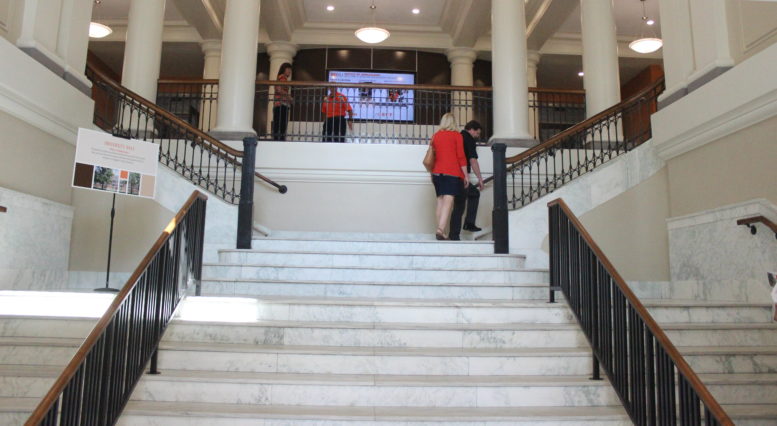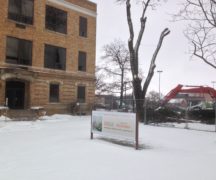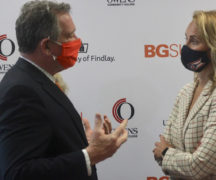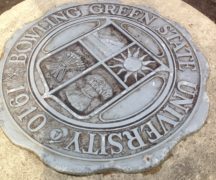By DAVID DUPONT
BG Independent News
Tom Gorman came into University Hall looking for his old window.
The long-time Bowling Green State University employee and graduate had worked in University Hall a number of years ago, and he visited the now renovated space checking out where he used to sit in a tiny cubicle.
The room on the first floor of the 102-year-old building is no longer cramped. Now home to the Center for Community and Civic Engagement, it is open and full of light.
This is the one, or maybe this one is the window, Gorman said, before wandering off to check out the rest of the renovated building and its neighbor Moseley Hall, where he had taken classes.
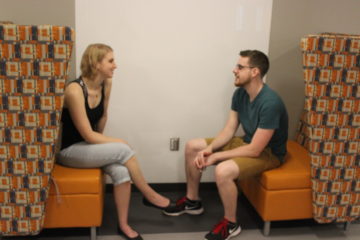
Joel and Amy Ashley chat during a tour of University Hall.
Gorman was one of the employees and community members who strolled through the buildings Thursday during an open house. The public will have another chance to visit the two buildings Saturday (Aug. 12) from noon to 2 p.m. Tours begin at noon and 1 p.m.
For her part V. Jane Rosser, the director of the Center for Community and Civic Engagement, said she liked having people like Gorman, “folks who know the building, who worked here, students, people who cleaned and folks from other units” drop by to look at the space. “They’ve been very impressed.”
Rosser is impressed as well with the office’s new space. In the 10 or so years the center has been in existence, she said, it has bounced from building to building wherever there was empty office space. “All out of the way,” she said.
Now the center is located in a place that’s easy to find, and part of a cluster of the university’s high impact programs. Those programs include, she said, intensive research, STEM programs, “specialized advising for students aren’t quite sure on their career goals yet,” community-based learning, learning communities, and international programs.
Rosser said she and the staff were excited to have close by “colleagues who we’ve been working with. Now we can just pop right in.”
“Many of us appreciate maintaining a sense of the tradition,” Rosser added, while making University Hall “a real student center.”
Staff of the programs in the building intend to make maximum use of the new active learning spaces. “We’ll have students in them in weekends and evenings and really using this as a hub.”
Paul Valdez, the center’s assistant director, said, the building “definitely reflects an opportunity for collaboration.”
Having the advising office across the hall, he said, is key. “When they’re having conversations about the value of experiential learning,” the Center for Civic Engagement, which can provide such experiences, will be right across the hall. “We’re already having discussions about how we make that connection more clear.”
Joel Ashley, who is starting his graduate studies in college student personnel, was with his wife, Amy, in one of the many cozy conference spaces spread throughout University and Moseley.
He liked what he saw in the new building. The interior was “modern and elegant, minimalist” with lots of open spaces. At the same time, “they retained a sense of the tradition.”
The two buildings were renovated for about $46 million. Moseley will be used for science teaching labs for chemistry, biology, geology and medical lab science.
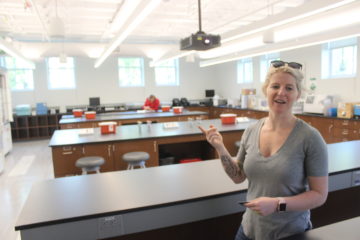
Emily Barnes Hanna talks about new Medical Laboratory Science space.
Emily Barnes Hanna, the lab coordinator for Medical Laboratory Science, said the new facilities will allow the university to enroll more students in the program. Labs have room for 24 students in a class, a 50 percent increase in seating.
The program graduated 16 students this spring, Hanna said, and every single one of them already had a job.
The new facilities also have updated equipment that will better prepare students for work in hospitals.
The chemistry labs also have new equipment, including new hoods. Those hoods, instructor Siobhan Shay said, won’t cause drafts in the room when not in use.
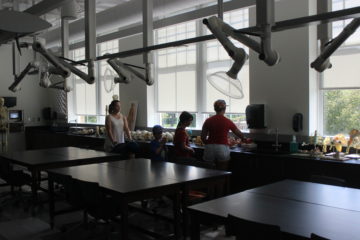
Biology lab in Moseley.
The larger space said Mary Toth, the lab supervisor, will mean greater efficiency for the classes. More materials will be stored here meaning fewer trips to the stockroom in Overman Hall, where the labs had been.
“For me it’s being able to be more organized and make it more efficient for the students.”
With larger number of hookups, students will not need to share while conducting experiments as in the old lab, Shay said.
The labs in Moseley are used mostly for first and second year students, with the exception of Medical Laboratory Science. The chemistry labs are for general and honors chemistry as well as elementary chemistry, which is taken by allied health and education majors.
“The students are mostly the ones who will notice how bright and shiny it is,” Shay said. “They’ll enjoy being somewhere new.”

